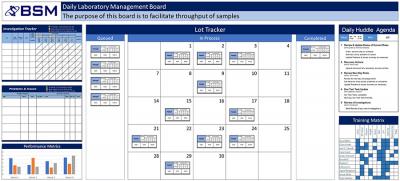Designing Visual Management for a Lean Laboratory
Visual management is an integral part of a Lean Laboratory. It unites personnel around a common goal, ensures that critical information is disseminated, and keeps the lab running smoothly. When a visual management board is well designed, anyone should be able to walk in and have a clear understanding of the labs operational status and current performance.
In order to design a sustainable and helpful visual board, ask yourself three questions:
- What is the goal of the board?
- Who will be using the board?
- What information do they need to accomplish the goal?
Too much information can be the death of a visual board, so it’s important to focus on providing the key players the information they need to accomplish their goal.
The above board’s goal is to facilitate the movement of samples through the lab and therefore each board section is directly related to that goal.
The Lot Tracker section keeps track of which stage each sample is in. There is a landing queue for samples that have entered the lab but have not yet started testing. There is an In-Progress calendar which allows for easy scheduling of analysts to sample assays. After the scheduled completion of the testing, the sample can move into the completed stage. The Lot Tracker is helpful in three ways. It allows for easy scheduling of analysts to assays, it shows overall workload of the laboratory, and it shows which analysts have extra resources available.
The Daily Huddle Agenda is essentially a checklist to focus discussion at a brief daily meeting held at the visual board. The meeting is held at a time which is convenient for all personnel, typically at the beginning or end of the shift. At the meeting progress vs schedule is discussed and short term action items assigned with particular focus on resolving issues that arose during the shift.
The Investigation Tracker and the Problems / Issues Tracker are very similar. They give clarity to any issues happening in the lab and assign a responsible party and a timeline to make any corrections. Having deadlines (artificial or not) creates urgency when problems have a tendency to stagnate.
The Training Matrix is posted so that assays requiring more trained personnel are clearly visible to the entire laboratory. This empowers employees to train on assays that need more personnel and makes scheduling quicker for management.
Performance Metrics are a method of continuous plan, do, check, act (PDCA). Depending on what the goal of the laboratory is these metrics can be varied but should typically comprise one each in the areas of Quality, Delivery and Productivity. We normally recommend that only metrics which facilitate / identify short term interventions are placed on a daily visual board, such as number of samples within X days of lead-time. A separate board which looks at medium term performance and facilitates continuous improvement activity will be the topic of a separate blog.
Remember that a visual management board is not a one size fits all. Creating something that will benefit your team requires thought and input from all involved parties.
Our consultants can provide further information on the above and discuss any aspect of Real Lean Transformation, simply set-up a call today.


